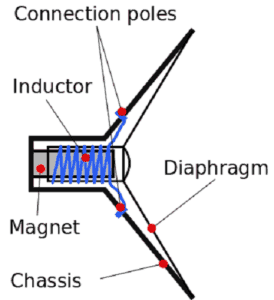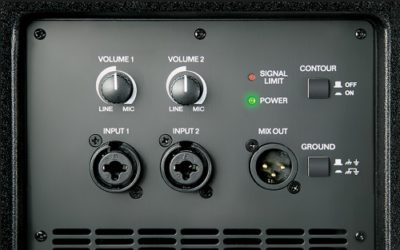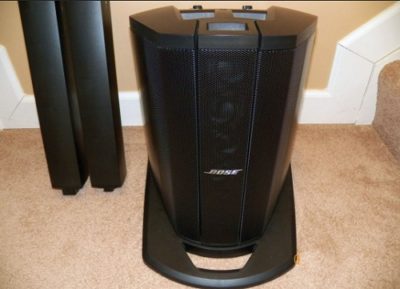There are many active and passive speakers available from numerous manufacturers in many configurations. We can sort them into two main types. Making choices when shopping will definitely be a challenge if you do not understand the concept and difference between passive and active speakers. We can help you with making the right choice for yourself.
The simplest explanation of these two types of speakers would be that an active speaker is one that has its own amplifier built into its cabinet while a passive speaker drags its power from an external amplifier. The basic difference is in the audio signal amplification and frequency band split of it using crossover filters.
How loudspeakers work
All speakers work by transferring electrical energy into mechanical motion. It will play loud or soft when the cone vibrates a big or a small amount. Bigger speakers with larger cones, called woofers move more slowly than smaller speakers with tinier cones known as tweeters. Because of that bigger speakers are better for producing lower frequencies. Essentially, any speaker can deliver a wide spectrum of different sound frequencies by moving back and forth quickly for high frequencies or slowly for low frequencies.

The parts and functions of a loudspeaker:
• The diaphragm moves back and forth permitting the air to move. This process creates sound.
• Dust Cap is made to protect the voice coil from dirt and dust.
• Surround is a lining which joins the basket with the diaphragm.
• The basket is a metal frame that holds the speaker together.
• Spider is a kind of suspension which keeps the pressure on the voice coil but also allowing it to move.
• The magnet is usually a rare earth neodymium or ferrite.
• Bottom Plate holds the pole piece and the magnet together.
• Pole Piece focuses the magnetic field produced by the voice coil.
• Voice Coil moves the diaphragm via the magnetic field created by the current in the wire.

Check out my list of 15 great products for church sound systems here
Passive speakers
In passive speaker systems, the signal is amplified by an external power amplifier or powered mixer.
After the signal is amplified, it’s being divided into several frequency bands suitable for reproduction through speaker drivers. A crossover network is in charge of splitting that amplified signal into multiple frequency bands and it is mostly located inside the speaker cabinet.
Passive speaker systems rule the hi-fi world so there is a big chance that you already own at least a pair of these speakers. You need to make sure that your passive speakers and amplifier are compatible with each other because of their impedance and power ratings. If you don’t, you risk either blowing your passive speakers up or not achieving the best sound out of them.

Active speakers
Active speaker configurations are usually used as professional concert audio equipment and studio monitors. In active speaker configurations, the audio splits frequency bands before being amplified. There are assigned amplifiers for each driver rather of one amp doing all the work. The active crossover and the amp is placed into the speaker cabinet. This is because of the tinier design of the active crossover. With some of the active speaker configuration, the audio designer is provided with the ability to be free to make an amplifier work best in selective frequencies, increasing the volume efficiency and precision.
Advantages and disadvantages
So what would be the downsides to either of these two types and the difference between active and passive speakers? The greatest issue with both passive and active speakers, besides the initial cost, is that you are degrading the flexibility you have in the future to make any changes in your system. You have the option of changing both the amplifier or the speakers to make improvements if you don’t like the sound of your current amp and speakers. With an active system, this really isn’t an option.
Speaker crossover
All speaker crossovers include some volume of loss. In some circumstances, it can 50% loss of power, which is really, you should admit, undesirable.
In passive speaker systems, the signal is already amplified so the crossover elements need to be quite extensive to be able to resist the amperage. Such massive crossover elements can cause distortions an phase shifts.
Frequency response
Various frequency bands need different amounts of power for their reproduction. In regard to passive speakers systems, since the single amplifier provides with power the full set of frequencies in the audio signal, it has to do a lot of work. Only larger and more expensive amplifiers are able to reproduce the entire frequency spectrum with enough power, which means more money out of your wallet.
Power ratings
Also, getting the proper amplifier for your passive speakers in terms of power ratings and impedance can be a little difficult so you need to know what you are doing.
Sound quality
While both types of speakers can sound equally good, you can often hear people talking how active speakers usually sound a lot crisper. This is not really true. The most sensitive and most expensive hi-fi speakers are actually passive as well as active too. But audio quality mostly depends on the configuration you choose.
Overall
The significant advantage of powered speakers is that its power loss is reduced to a minimum so efficiency is on a much higher level. Active crossovers, do much better work with splitting frequencies before amplification. It provides much better and controlled bass frequencies so it is not surprising why most of today’s subwoofers are active. Another plus, is that you don’t need speaker cables as the inputs to powered speakers can be direct from a microphone, guitar, keyboard or mixing desk. XLR cables instead of speaker cables from your mixing console are all you will need.
You may be interested in my other post – 101 Ideas for Church Sound Systems
FAQs
Can I connect powered speakers to an amplifier?
I suggest you do not connect active speakers to an amplifier. It’s not a good idea because active speakers are already amplified. You could cause damage to the active speakers while they are in use and lead to expensive repairs. It is better to use passive speakers with an amplifier. You mind find this post helpful if you need to find out how to tell if speakers are damaged.
Can a mixer power passive speakers?
The answer to this question depends on the type of mixer. If your passive speaker doesn’t have an amplifier built-in, then you will need to plug it into a powered mixer or power amp with a subwoofer output in order for it to work properly. If you are using an unpowered mixer, then it will not be able to power passive speakers. You will need to have a power amplifier between your mixer and your passive speakers in order for your speakers to work.
Can you daisy chain active speakers?
This really depends on your speaker configuration. If you are using active speakers with an amplifier, then yes. Connecting one powered speaker to another is as easy as daisy-chaining the units together. The amplifier inside each speaker feeds only its own internal speakers, so impedance isn’t a concern. But if you have passive speakers and no amplification system, the answer is no.
On the other hand, if you want to daisy chain active speakers with passive ones that depend on your powered speaker system. Usually, the active speakers send out a non-amplified signal only and the passive speakers need an amplified one. So that can’t work. The drivers will become less responsive and sound weak, and, more importantly, you risk overheating your active crossover. So we don’t recommend this. So we suggest that you consult with the professional audio engineer about your speaker configuration and follow the instructions given by the manufacturer.
But if we are talking about active studio monitors, they actually work exactly this way. Not all, but most of them have an amp in just one speaker which provides power to another one. Many powered computer speakers can work in a daisy chain, having their power switched from one to the next.


Leave a Reply